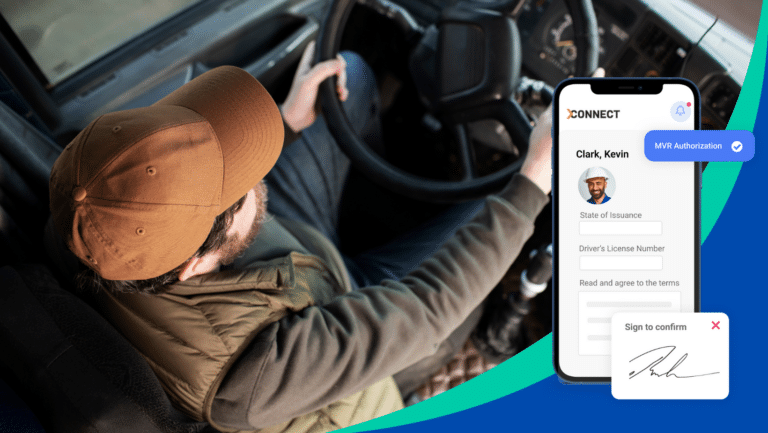5 Safety Messages for Drivers to Reduce Accidents

Reinforce healthy driving habits with these safety messages
Creating a culture of safe driving within an organization involves implementing policies and procedures that prioritize safety on the roads. Providing comprehensive driver training, safety equipment, and regular vehicle maintenance are all essential components of creating a culture of safe driving.
Promoting safe driving practices through communication and education campaigns can also foster a sense of responsibility and accountability among employees. By sharing daily safety messages, you can ensure good driving habits are top of mind.
So, before your drivers hit the roads, be sure to share these safety messages for a safe and smooth driving experience.
Safety Message 1: Reduce Distractions
Did you know that distracted driving is responsible for around 25% of all vehicle crashes? According to the National Highway Traffic Safety Administration, distracted driving was responsible for 3,142 deaths and 424,000 injuries in 2019.

To reduce distractions while driving, it’s important to remind employees that multitasking is a myth. According to some studies, our brains can’t actually juggle more than one task at a time. It takes just a few seconds of your eyes or hands being off the road for accidents to occur.
Distracted driving can happen in different forms like using the phone to text, looking at the GPS, using the mirror to put makeup on, searching for items in the car, eating, putting the music too loud, or driving while on meds. By being aware of the different types of distractions, employees can significantly reduce the risk of accidents and keep themselves and others safe on the road.
Safety Message 2: Manage Time and Speed
Speeding is a dangerous and reckless behavior that endangers not only the driver but also others on the road. Speeding reduces the ability to react to unexpected situations and increases the distance required to stop the vehicle. Additionally, high speeds can cause tires to lose traction, making it difficult to control the vehicle.
Some tips to help break the habit of speeding include planning the trip before heading out (checking distances and routes), using cruise control, checking the speedometer, identifying speeding triggers, and practicing calming exercises.
💡 Remind your drivers: “It’s better to lose one minute of your life, than your life in one minute.”
Safety Message 3: Check your blind spots
Driving requires full attention and focus. One of the most common challenges that drivers face is managing their blind spots. These areas around the vehicle that are not visible in the rearview or side mirrors can create potentially dangerous situations on the road.
To manage blind spots effectively, drivers need to adjust their mirrors correctly, check blind spots before changing lanes, and use caution when passing other vehicles. Additionally, keeping a safe distance from other vehicles and avoiding distractions like texting or eating while driving can help reduce the risk of blind spot accidents. By staying vigilant and aware of their surroundings, drivers can navigate the roads with confidence and safety.
Safety Message 4: Understand traffic signs and signals
Understanding traffic signals and signs are crucial for all drivers on the road. Road signs provide important information such as speed limits, the direction of travel, and potential hazards ahead.
It is important to help your drivers familiarize themselves with traffic signals and signs before hitting the road to ensure a safe and smooth driving experience. Also, red means STOP!

According to the Department of Transportation, on average, every 20 minutes a driver runs a red light.
Safety Message 5: Be aware of stopping distances
The distance it takes for a vehicle to come to a complete stop depends on various factors, including the speed of the vehicle, road conditions, and the driver’s reaction time. As a general rule, the faster a vehicle is traveling, the longer it takes to stop. For example, a car traveling at 60 mph will take about 240 feet to come to a stop, while a car traveling at 30 mph will take only 75 feet. It’s important to remember that these are just estimates and that other factors such as weather, tire condition, and vehicle weight can also impact stopping distances.
To ensure the safety of your drivers and the safety of others on the road, it’s crucial to always maintain a safe following distance ( 3 car lengths) and be aware of the surroundings to react quickly in case of an emergency.
Safety first, today and every day
By investing in a culture of safe driving, organizations can protect their employees, reduce liability, and demonstrate their commitment to responsible business practices. Safety messages should be part of everyday conversation and must be reinforced with the use of driver training.
If good driving is important to your organization, make sure driver training becomes the heart of your safety program. At Embark Safety, we offer online driver training integrated into our MVR Monitoring platform. You can choose to assign customized driver lessons to target high-risk drivers, for new employee orientation, assign yearly training, and more.
*We are not lawyers. Consult with your legal counsel to ensure your processes and procedures meet/ or exceed safety standards and compliance regulations. Please read our legal disclaimer.






